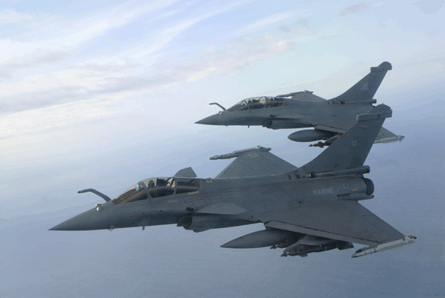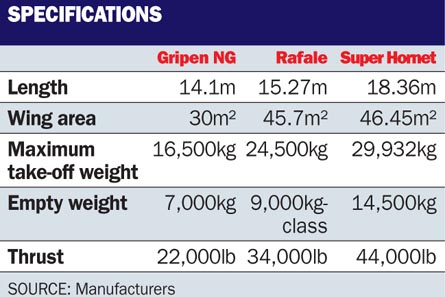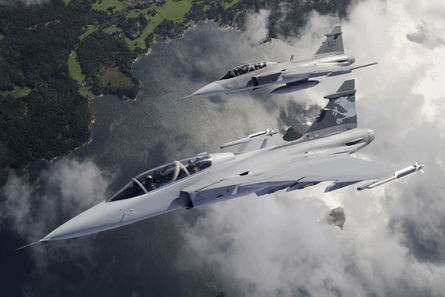Between September 2009 and January 2011, Brazil's F-X2 fighter competition seemed more like a power struggle than an evaluation process, with the state's political leadership favouring the Dassault Rafale and the air force preferring either of two alternatives. In this narrative, the winning bid would belong to the victorious side of an internal battle within the Brazilian bureaucracy, with most bets on the Rafale - President Luiz Inácio "Lula" da Silva's declared favourite.
However, the dynamics of the competition, worth at least $6 billion, completely changed on 6 December 2010, when da Silva ceded the F-X2 decision to his successor and former chief of staff Dilma Rousseff, who became president on 1 January 2011.
 |
|---|
© BoeingBoeing's Super Hornet joins the Dassault Rafale and Saab Gripen on the FX-2 shortlist |
Instead of a logjam, the F-X2 programme was suddenly given a clean slate three years after the Brazilian air force formally reopened the acquisition process.
Rather than choose from the three original bids submitted in February 2009, Rousseff extended the evaluation process for a new analysis, which will take at least several months.
At the same time, Rousseff is also balancing projected outlay for the F-X2 contract against one of her other top domestic goals - maintaining a stable economy.
Although Brazil's gross domestic product has accelerated, despite a global recession, inflation is still rising faster than government targets. In an attempt to put a brake on rising consumer prices, Rousseff slashed government spending, with the ministry of defence's acquisition portfolio suffering some of the deepest cuts - 26.5% this year.
Defence minister Nelson Jobim played down the potential impact cuts could have on the F-X2 evaluation but left himself room for manoeuvre, perhaps, with a carefully worded statement saying the budget cut would "not necessarily" hit the F-X2 project this year.
In any case, Nelson points out that outlays for the next-generation fighter will not be registered until 2012 or 2013, even if the winner was selected this year. The selection would also be followed by a long period of firm price negotiation which, Jobim notes, lasted 12 months during the Brazilian navy's recent submarines acquisition. The shift in political leadership has given new hope to the Rafale's competitors - the Boeing F/A-18E/F Super Hornet and the Saab Gripen NG.
"We're encouraged by what we've seen since Rousseff was inaugurated earlier this year," Joe McAndrew, Boeing's vice-president of business development for Europe, Israel and the Americas, says, noting that the result will be "judged on the merits of the airplane and the value of the [economic] offset".
Boeing's confidence may also be bolstered by other signs that momentum in the competition is moving away from the Rafale.
Last month, Rousseff was widely reported to have told Timothy Geithner, secretary of the US Department of Treasury, that the Super Hornet was her favourite in the evaluation.
Rousseff's reported endorsement follows a recent disclosure that Frederico Curado, chief executive of Embraer, also supports the Super Hornet bid. In a diplomatic cable dated January 2009, Curado informed then-US ambassador Clifford Sobel that he "privately hopes Boeing wins", although Embraer's official position on the F-X2 is neutral.
 |
|---|
© Dassault |
However, Boeing's biggest trump card was played on 20 March, when US President Barack Obama met Rousseff on his first visit to Brazil. According to White House officials, Rousseff raised the Super Hornet bid first during a private meeting and Obama repeated his administration's assurances about full transfer of technology - the key sticking point in the Boeing bid. There is a strongly held view in some quarters of Brazilian government and industry that US export policies cannot be relied on. In October 2009, Brigadier Engineer Venancio Alvarenga Gomes, director of projects for Brazil's aerospace technology command, was caught on camera issuing a warning during a lecture about his organisation's experience with the US export control process. Foremost among concerns was a perceived inconsistency in the application of US policies, which had forced the Brazilian air force to scramble repeatedly on previous programmes, Gomes said.
Gomes's presentation concluded with an image of the F/A-18E with a red "X" stamped over it - not a great endorsement from the head of the Brazilian air force's top aeronautical research organisation. On the other hand, the security relationship between the USA and Brazil has continued to evolve since 1977, when Brazil unilaterally withdrew military co-operation with the USA.
 |
|---|
In 2008, the US Department of Defense reconvened a bilateral working group with Brazil for the first time in six years. Last November, the USA and Brazil signed a general security military information agreement, which allows the USA to exchange classified information with Brazil.
The agreement was signed despite serious diplomatic disagreements. Only two months earlier, da Silva's administration had refused to support US efforts to invoke United Nations sanctions on Iran. "There have been significant policy dust-ups between the US and Brazil, especially over Iran, and nobody made any mention of technology transfer," McAndrew says. Before Wikileaks indicated the Super Hornet was a secret favourite of Brazilian authorities, Saab's bid enjoyed that status. Last January, the Folha de São Paulo newspaper leaked a summary of the air force's 27,000-page evaluation report, which reportedly ranked the Gripen NG as the service's first choice to replace the Dassault Mirage 2000-5.
Bengt Janer, Saab's Gripen campaign director in Brazil, says Brazil's air force and industry have a chance to become part of a supply chain featuring the next-generation of Sweden's single-engined fighter.
"Although we are proposing a development programme which could be seen as a riskier business," Janer says, "this development programme is based on a fighter that has been sold to five countries. The air force saw this early and they said this is what they want."
 |
|---|
© Jamie Hunter/Saab |
Saab's sales pitch is less about political forces than building industrial capability, he says. "What is unrestricted technology?" Janer asks, referencing the air force's requirement for export release. "What is it that really interests a country like Brazil? Is it a radar? Is it an engine? What Saab proposed is we share technology with Brazil in the integration of different systems."
Sweden may lack the star quality of a state visit by a US or French president, but the Gripen has been fully supported by its country's political leadership. In addition to several visits by defence minister Sten Tolgfors in 2009, Brazil has also been personally lobbied by Sweden's king and queen.
If any country has claimed political advantage in the competition so far, however, it has been France. On Brazilian independence day, 7 September, in 2009, visiting French President Nicolas Sarkozy secured da Silva's promise that Brazil would buy 36 Rafales in exchange for France purchasing 12 KC-390s. That deal was followed by a long period of price adjustment. By August, local reports had Rafale emerging as the top-ranked aircraft in the air force evaluation, even though it was still the most expensive. The ranking was reportedly changed to make technology transfer more important than operating cost.
Source: Flight International
















